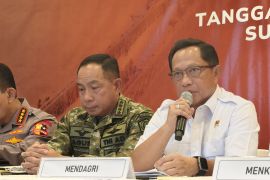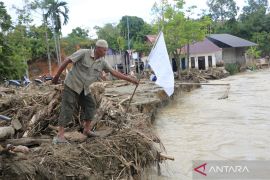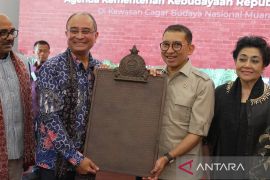If nothing is done, the Oirata language is feared to become extinct sooner or later."Jakarta (ANTARA News) - Indonesia joined with the world to observe International Mother Language Day on February 21, 2014 to promote the preservation of local languages in the country.
Sugiyono, the Head of the Center for Language Development and Protection at the Ministry of Education and Culture, said his agency was working to preserve hundreds of local languages in Indonesia.
"We have at least two main strategies, namely language documentation and language revitalization, to prevent endangered ethnic languages from becoming extinct," he said here on Friday.
Besides, he noted that another important step to be taken to preserve languages was to provide the opportunity for younger and older people to meet as often as possible to practice their mother languages.
According to Sugiyono, Indonesia has more than 746 ethnic languages across the country, but many of them are feared to have disappeared because the declining number of those fluent in these languages.
The ethnic languages in Indonesia belong to both the Austronesian or Malay language families, and non-Austronesian or Trans New Guinean language families.
Particularly, the languages in the eastern part of Indonesia are classified as part of the language of minorities because of the continuously decreasing number of speakers.
The endangered Oirata language is one of them.
This language is spoken by the people of Oirata Barat and Oirata Timur villages on the island of Kisar, Southwest Maluku (MBD) district, in the province of Maluku.
Based on the 2010 population census, the two villages have a total population of 1,566, but only a few of the inhabitants are able to communicate in the Oirata language, while the others speak Ambonese Malay dialect in their daily interactions.
In reality, less than 500 people over 50 years of age are able to communicate well in Oirata language, while their children and grandchildren are unable to do so.
"If nothing is done, the Oirata language is feared to become extinct sooner or later," according to Prof. Tanwey Gerson Ratumanan of Ambon Pattimura University (Unpatti), speaking during a seminar in September last year.
With the extinction of this language, the people who speak it in the villages of Oirata Barat and Oirata Timur will lose not only their cultural wealth, but also important ancestral knowledge embedded in the language.
Ratumanan noted that the extinction of the Oirata language could cause the disappearance of local traditions, such as values, rules, norms, customs and habits.
He then asserted that the endangered Oirata language must be preserved, so long as parents in the two villages teach the language and culture to their children and grandchildren.
Therefore, through the protection of cultural heritage as part of the nation's priority, the Indonesian Institute of Sciences (LIPI) is making every effort to document the Oirata language and prevent it from becoming extinct.
"Through the documentation of the Oirata language, we hope the government and language observers will give serious attention to its preservation," said Soewarsono, a LIPI researcher, during the seminar on the "Revitalization of Oirata Language" in Ambon, Maluku.
According to him, the seminar, attended by various groups from Oirata Barat and Oirata Timur villages, and speakers from LIPI and Unpatti, seek to find a solution to prevent the Oirata language from becoming extinct.
Soewarsono pointed out that according to UNESCOs Ad Hoc Group on Endangered Languages, there are nine factors that can determine the viability of a language, its function in society and the type of measures required for its maintenance or revitalization.
Among the nine factors are the inter-generational language transmission, absolute numbers of speakers, proportion of speakers within the total population, and amount and quality of documentation.
Based on their study, Soewarsono said they found that inter generational language transmission and the proportion of speakers within the total population continued to decline.
"We have found that the speakers over 50 years old continue to switch from Oirata language to Ambon Malay dialect when speaking to their children and grandchildren at home," Soewarsono noted.
But, he added that the language plays an important role in the social structure of the Oirata people because every clan in the two villages has its own unique myth, that can be told in the Oirata language during the system of marriage.
"However, the number of speakers in the customary system of marriage also continues to decrease with the passing of time," Soewarsono went on.
Meanwhile, Nazarudin, a lecturer of linguistics at the University of Indonesia, says the Oirata language has some characteristics and five simple vowel sounds, with a few variations of allophone, one of two or more variants of the same phoneme, which also appear in the non-Austronesian.
"Therefore some linguists classify the Oirata language into the non-Austronesia or Trans New Guinea language family," Nazaruddin says.
The Oirata language is unique in its structure and use, and thus it is a great concern that it is under the threat of extinction.
Therefore, Nazarudin said his team of researchers in 2014 will focus their study on the development of the system of spelling, as part of an effort to revitalize the Oirata language.
"During our research this year, we will try to find the best solution to the problem of Oirata language in our effort to revitalize and develop the language and culture," Nazarudin said.
Citing a statement by the Summer Institute of Linguistics (SIL), the linguistics teacher of the University of Indonesia said a peoples identity and culture are intimately tied to their language.
He noted that words that describe a particular cultural practice of ideas cannot be translated precisely into another language.
Nazaraudin added that Oirata is one of many endangered languages which has rich oral cultures that include stories and myths passed on to younger generations, but not in written forms. (*)
Reporter: Otniel Tamindael
Editor: Priyambodo RH
Copyright © ANTARA 2014












